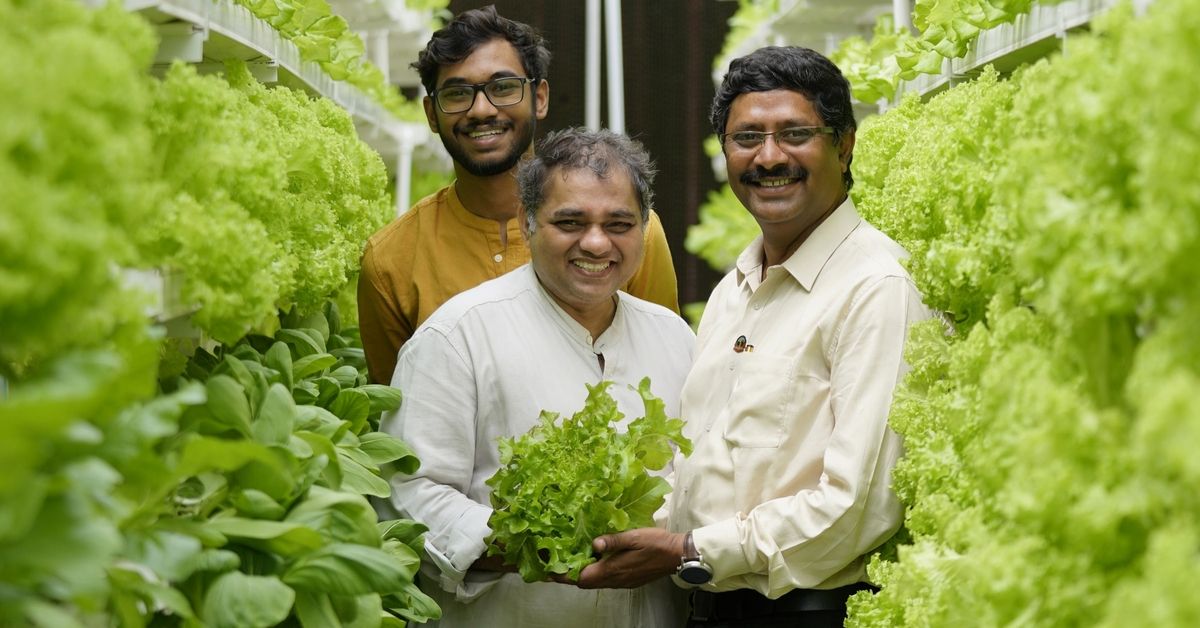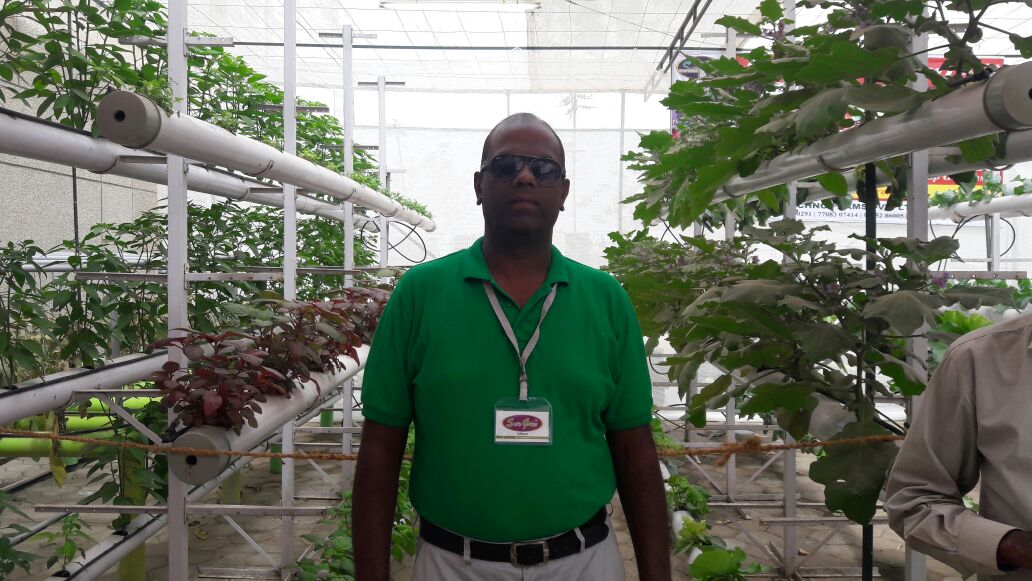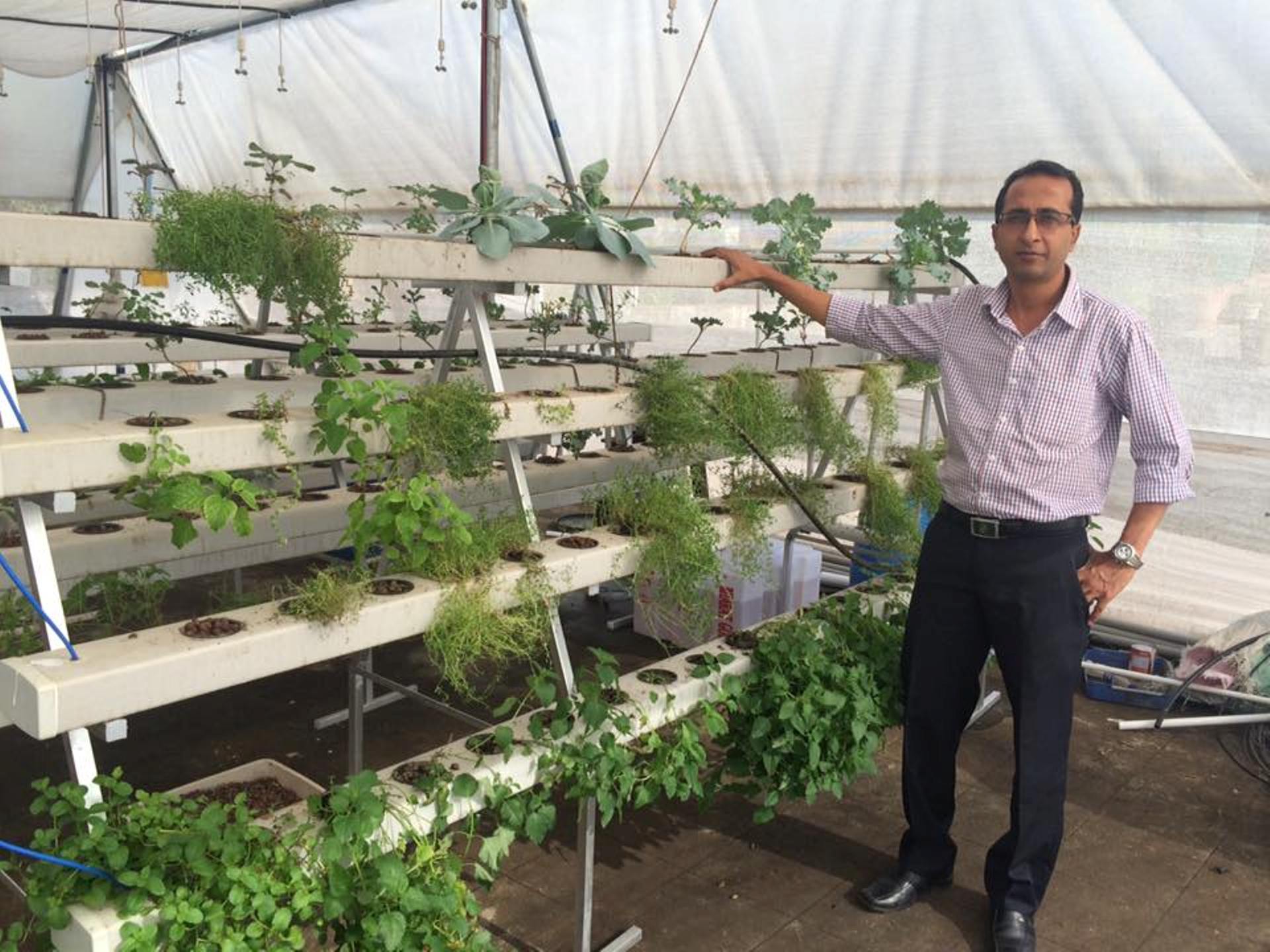Soil-less & Vertical, This Style of Farming Will Reduce Water Usage By 95%!
If one has a 1000 sq ft plot of land, vertical farming on it yields a harvest which is equivalent to 3,000-4,000 sq ft of plot. Moreover, with a crop cycle of 3-4 times a year, the profits are substantial as compared to traditional farming.

A silent but new revolution is taking place in the agricultural sector. In prehistoric days, especially in the Neolithic age, human beings started farming. Later, in the late 18th and early 19th centuries, they started the multicrop farming and farm breeding.
Now, it is the time of Vertical or V-farming.
In simple terms, V-farming is a method to produce leafy veggies (spinach, amaranthus, mint, lettuce, kale, basil) and some non-tree fruits (tomatoes, brinjal, strawberries) where there is nearly no available arable land; these are grown in vertically stacked layers made of PVC pipes resembling a multi-storied building of plants. The plants are grown in a controlled environment under artificial lighting using LED bulbs, either in a building and polyhouse on rooftops or open land.
V-farming can be either aeroponics (growing plants in air or mist without the use of soil or an aggregate medium) or hydroponics (growing plants using mineral nutrient solutions in water solvent without soil).
Though there is no exact data on how many V-farms are there in India or in the world, what farmers know is that it is a very high productive farming, with nearly 70-80 per cent more harvest per unit of area. If one has a 1000 sq ft plot of land, vertical farming on it yields a harvest which is equivalent to 3,000-4,000 sq ft of plot. Moreover, with a crop cycle of 3-4 times a year, the profits are substantial as compared to traditional farming.
25-year-old Vihari Kanukolla of Urban Kisaan adds, “Soil-less V-farms help grow pesticide-free vegetables using 95 per cent less water than traditional farming. And that too, in a clean and hygienic environment. A user can be assured of consuming quality vegetables.”
Urban Kisaan was founded by Dr Sairam, Srinivas Chaganti and Vihari Kanukolla in Hyderabad in 2017. Srinivas Chaganti says, “The best part of V-farming is that you can have year-round production. It can be urban-centric, thereby cutting down on the cost of transportation and retaining the freshness of the produce. The crop has the added advantage of reduced susceptibility to weather extremes.”
Then there are brothers Benjamin and Brian Zehr who started a hydroponics farm, Kisano, in Mumbai last year. They feel, “V-farming is the way to reduce carbon footprints. We need this type of farming to feed the next billion people without destroying our planet.”
They claim that there is lesser usage of water and absolutely no chemical fertiliser or pesticides; if need be, only neem leaf extract is sprinkled.
Elaborating the advantages, the marketing head of Suregrow, K R Karthikeyan says, “Leafy vegetables start losing their nutrients within 8-10 hours of harvesting. They aren’t like apples, which can be transported from Himachal Pradesh to Kanyakumari. So if you lose a day in transporting, by the time they come to your dining table, they are just green without much nutrient value left in them. With V-farms being in cities or on close outskirts, a consumer can be assured of getting real farm-fresh veggies.” Suregrow is the vertical farming brand of Coimbatore-based Pennysworth Techno Farms P(Ltd).
Innumerable other V-farmers are mushrooming not only in India but also in the world. AeroFarms is one of the biggest Vertical farms in Newark in New Jersey, spread over a 69,000 sq foot warehouse. Japan’s Mirai V-farms operates from 12 locations including a 25,000 sq ft farm, with a capacity of harvesting 10,000 lettuce heads a day. The next biggest V-farm is coming up in Dubai in January 2020, on a 1,30,000 sq ft area to produce 6,000 pounds (nearly 2,772 kg) of green veggies per day.
“We are growing nearly 320 bunches of Indian greens in a 260 sq ft V-farm via hydroponics, and we can have 20 such harvests in a year. One can get nearly 15,000 kg of red and yellow capsicum in a 10,000 sq ft area in a single harvest. We can have three such harvests in two years,” explains Prof C V Nagendhiran, the founder of Suregrow.
Explaining the popularity of the produce from V-farming, K Latha, assistant director of horticulture at the Telangana State Centre of Excellence (TSCoE) in Jeedimetla, says, “People have become aware of the importance of safe food. This kind of farming, especially if it is done on rooftops, backyards, or small open land in neighbourhoods, will ensure quality veggies, saving food miles. But a lot of research needs to be undertaken to make it viable. At present, there isn’t much.”
She adds that although one can get a good yield, proper marketing outlets are required. About two years ago, the TSCoE had started cultivating broccoli, but as there weren’t many takers, they had to abandon that project.
Vihari of Urban Kissan and Karthikeyan of Suregrow agree on the necessity of a marketing strategy. “One should tie-up with local supermarkets where there are outlets for quality veggies or with good eating joints where they use farm-fresh veggies.”
The upcoming Dubai V-farm has already tied up with the Dubai Airport, along with international flights which have a significant daily demand for greens.
It may take a few decades for it to run parallel with traditional horizontal land farming, which is at least a thousand years old. But the speed at which we are losing land to the world of constructions, changing villages into small towns and with population explosion (7.7 billion at the last count by the United Nations’ Worldometers), we will soon run short of land to grow food to meet the demands of an increasing number of mouths.
“V-farming or Urban farming, which includes hydroponics and aeroponics, can never take over traditional farming. It can’t substitute for tree produce or cereals like rice, wheat and dals. But this is the future for shrubs and herbs,” opines Prof Nagendhiran.
And there are some minus points also. Initial investment costs lakhs of rupees which is unaffordable for ordinary farmers anywhere in the world. Abroad, many of these farms being supported by financial companies; for instance, the Dubai V-farm is being supported by Emirates Flight Catering and Crop One Holdings. It began with USD 40 million and raised USD 100 million, which will go towards R&D and technology.
Many V-farms opt for venture funding. In India, however, no financier has come forward to finance them. If a person applies for farm loan for V-farming, it might not be sanctioned because there has to be a piece of land for a farm loan. But they could apply for a loan a business venture to sell farm produce.
Vijay Yelmalle of Kharghar, Maharashtra, of CRAFT (Center for Research in Alternative Farming Technology) trains urbanites in hydroponics; he travels across rural regions, teaching farmers about its advantages. He says, “Banks do sanction loans if the farmer presents V-farming as a business venture. At present, V-farming is a business as most of the players are from the corporate world.”
Another minus point is that supporters of V-farm claim to reduce carbon footprints. But as the veggies grow in artificial lights, the consumption of power is great. Even though they use LED bulbs, 24-hour consumption of power amounts to a lot. The Dubai V-farms says they aim to use a mix of power grid energy and solar power.
For this, one has to know the perfect technique. Entire crops can fail with a slight change in the pH level of the solvent or because of a slight variation in temperature. It needs constant monitoring. One has to learn it thoroughly before venturing into it. Most practitioners like Urban Kisaan, Suregrow, Kisano, CRAFT and TSCoE offer intense training services.
Suregrow has helped set up V-farms almost all over India except in Punjab and Kashmir; it offers three-step training. “We offer information, training and hand-holding for a year to guide our clients to become experts in whatever veggies they want to grow. We even teach them to install the V-farm at a minimum investment. In the next five years, all over the world, vegetable farming techniques will change. We need to keep abreast,” concludes Prof Nagendhiran.
Also Read: Ex-Navy Commander Trains 10,000+ People To Grow Their Own Food Through Hydroponics!
So when multistory buildings were invented during Greek and Roman cities (Roman insulae) to provide cheap residences, they may not have realised that they were laying the foundation for future techniques for vertical farms. But looking at the fast burgeoning populations, vertical farms may just become the norm for a majority of vegetable production by 2050.
(Edited by Shruti Singhal)
Like this story? Or have something to share?
Write to us: [email protected]
Connect with us on Facebook and Twitter.
This story made me
- 97
- 121
- 89
- 167
Tell Us More
We bring stories straight from the heart of India, to inspire millions and create a wave of impact. Our positive movement is growing bigger everyday, and we would love for you to join it.
Please contribute whatever you can, every little penny helps our team in bringing you more stories that support dreams and spread hope.



















